A Private Tour today. Rather than a general day of birding, we had a list of target species which we would be looking for, as well as trying to see various other birds on the way. It was a dry day, bright at times, but with a very blustery SW wind which at least had the benefit of being rather mild. A daytime peak of 15.5C is warm for this time of year, though it didn’t always feel like it in the wind!
Our first target was Lapland Bunting. There have been a few in recent weeks in the fields along the coastal cliffs at Weybourne, so we headed over there to start the day. As we walked down the lane, there were a couple of Blackbirds and Robins in the sparse hedges, possibly recent arrivals from the continent for the winter. There had apparently been one or two Lapland Buntings in the clifftop grass earlier, but there were several dogwalkers strolling up and down there now, so we concentrated on the field instead.
Most of the birds were hard to see out in the stubble in the middle of the field at first, and all we saw was occasional groups of birds flying round before landing back down out of view, mainly Skylarks and Meadow Pipits. Then the first Lapland Bunting appeared with a group of Skylarks. It was very hard to get onto in flight though and landed back down out in the middle. The birds were very skittish in the wind and we were treated to several more brief flight views of Lapland Buntings over the next few minutes as we waited. We could just hear their distinctive flight calls as they flew round, over the wind.
When an RAF jet came low overhead, all the birds flushed from the middle of the field and it was amazing how many were out there. There were lots of Linnets, in one or two large flocks, plus more Skylarks than we might have thought, watching from the side of the field.
There is a more open area of bare mud close to the side of the field and gradually birds started to land on or around it. Meadow Pipits and Skylarks at first, but then two Yellowhammers flew in too, catching the morning sun. Eventually a Lapland Bunting dropped in, landing in the stubble just beyond the bare patch. We got it in the scope and could just see it creeping around in the stubble, noticeably different from all the other birds we had seen here.
Unfortunately, not all the group managed to see the Lapland Bunting before it flew off again. There were a few other birds to see here too though, particularly a large flock of Pink-footed Geese which must have been feeding or loafing in the fields over towards Sheringham Park. When they were disturbed by one of the passes by the RAF jet, they all flew up calling.
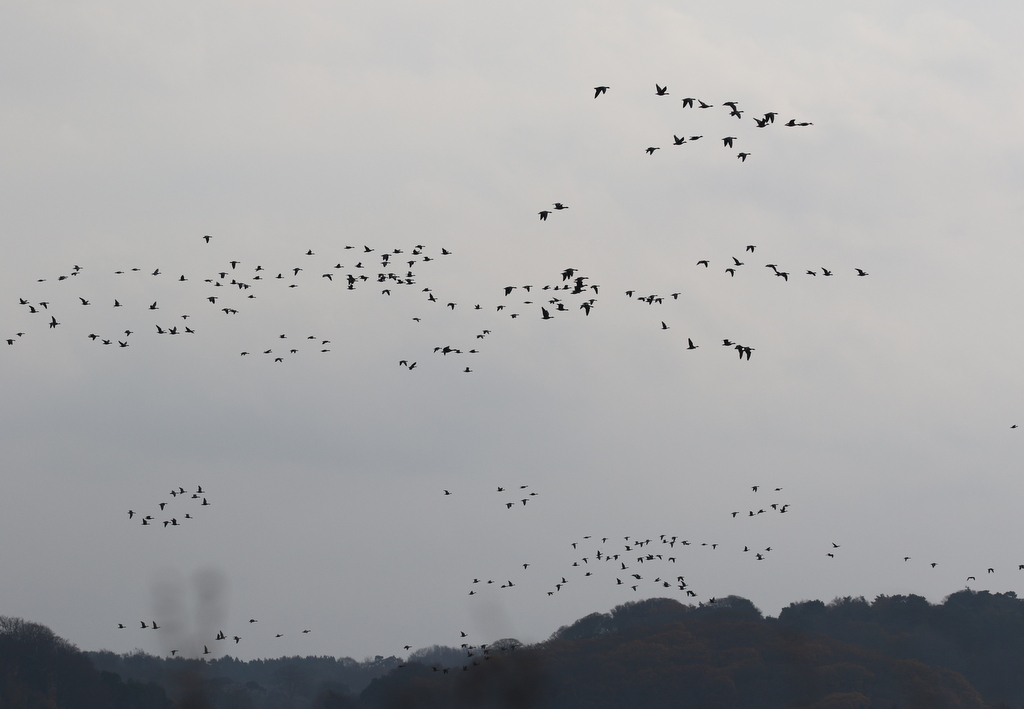 Pink-footed Geese – flushed from the fields towards Sheringham Park
Pink-footed Geese – flushed from the fields towards Sheringham Park
One of the Lapland Buntings appeared to land further over, along the other edge of the field, so we walked round to see if we could pick it up from that side. Unfortunately, as we got round there, a dogwalker walked up along the grassy strip on the edge of the field. They then proceeded to walk out into the field along the edge of the stubble, and all the birds flushed and landed back down in the middle.
We made our way back to the gate where we had been earlier and fortunately, some of the birds started to drift back towards that corner. Another Lapland Bunting dropped down into the stubble behind the bare patch and again we managed to get it in the scope, where it was possible to see it creeping around in the stubble. Then a tractor drove up the lane with a flail, to cut the margins of the field. The driver stopped to open the gate and asked us what we were looking at, then very kindly offering to start on the far side of the field so as to minimise the disturbance. We figured this would be a good moment to move on.
Our next stop was at Kelling. There were not many birds in the lane this morning, just a few Blackbirds and Chaffinches, so we walked straight down to the Water Meadow. There were a few birds around the pool – a handful of Teal feeding along the back edge and several Black-tailed Godwits out in the middle, probing into the water with their long bills.
The Spotted Redshank was on the edge of the vegetation on the north edge, where it likes to feed. We stopped for a quick look from the other side, then made our way round for a closer look. Unfortunately, before we could get there, something spooked it and it flew further out and landed on the muddy edge. A juvenile Ruff flew in to join it and a Common Redshank too.
The Spotted Redshank and the Common Redshank fed together on the edge of the water for a few minutes, given us a great side by side comparison in the scope. The Spotted Redshank was a little bigger, longer legged and noticeably paler, more silvery grey above and whiter below. We could also see its much longer, finer bill. The Spotted Redshank is a first winter, we could see its darker wing coverts and tertials. It has been lingering here for several weeks now and looks like it may stay for the winter.
 Spotted Redshank – lingering on the pool at Kelling Water Meadow
Spotted Redshank – lingering on the pool at Kelling Water Meadow
Then the Spotted Redshank went to sleep on the edge of the water. We had a quick look for any Jack Snipe around the edge of the pool, but the water level has risen here after the recent rain. The area where they had been roosting is now rather wet and none have been seen since last weekend. We decided not to linger here and moved on.
As we wound our way west along the coast road, we came across a field chock full of Pink-footed Geese. The sugar beet here was harvested a couple of weeks ago now, but still the geese are coming in to feed on the tops left behind by the harvester. We found a convenient layby to pull in for a closer look and there were well over a thousand geese in view and more out of sight in the field. We could see the pink legs and feet on the closest birds as they picked around in the field beside us, as well as their dark heads and delicate bills with a pink band.
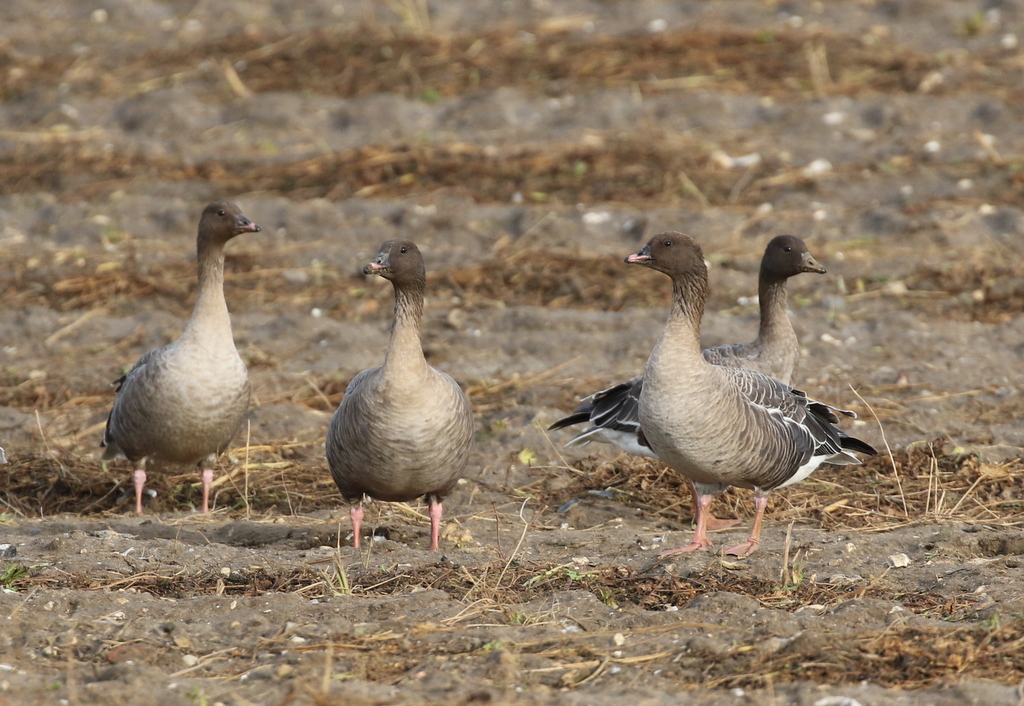 Pink-footed Geese – feeding in the harvested field by the coast road
Pink-footed Geese – feeding in the harvested field by the coast road
With a little bit of time still before lunch, we headed round to Cley. There has been a Black Brant with the Dark-bellied Brent Geese here for several weeks now and in recent days it has been feeding in the Eye Field. As we drove up the Beach Road, we could see lots of Brent Geese feeding out in the grass, but even as we pulled up, small groups were flying off towards the reserve, presumably for a drink and a bathe.
Apparently, the Black Brant had been seen here earlier but there was no sign of it now. We had a good look through at the Dark-bellied Brent Geese. Just behind them, a large flock of Golden Plover were catching the sunshine.
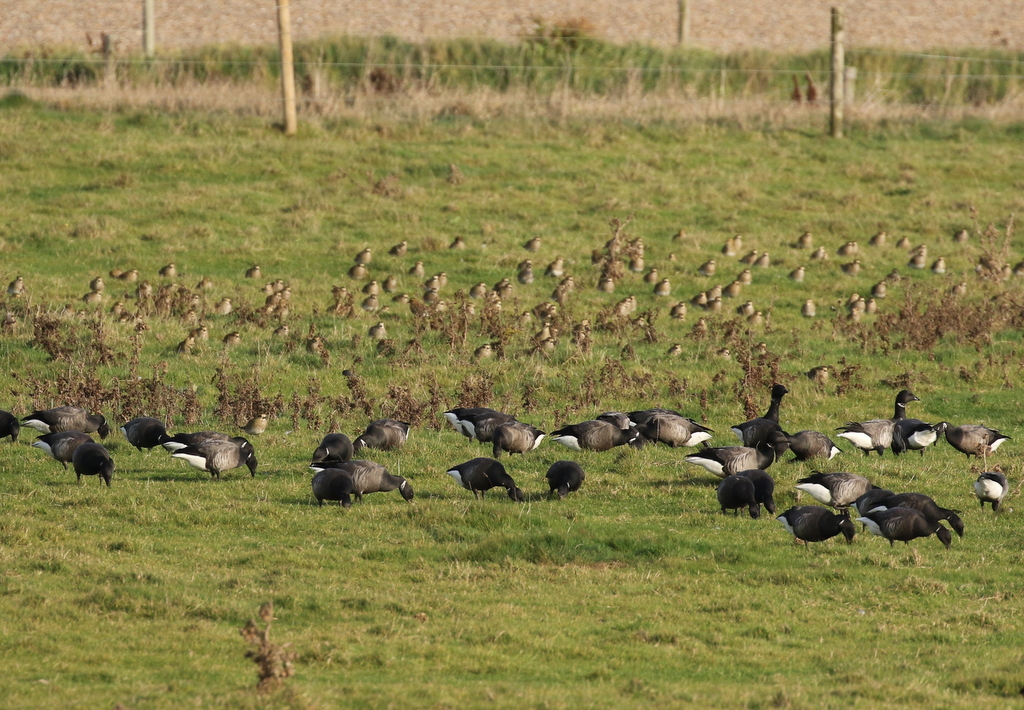 Brent Geese & Golden Plover – in the Eye Field
Brent Geese & Golden Plover – in the Eye Field
With the likelihood that the geese which had flown onto the reserve would return to resume feeding later, we decided to go off and have something to eat ourselves, before coming back for another look. It was rather breezy round at the visitor centre, but we still managed to make use of the picnic tables, as well as enjoying a hot drink from the cafe.
A few Ruff flew up from the reserve and headed off inland over the car park to feed in the fields inland. Something flushed all the Golden Plover from the Eye Field. We could see them whirling around in the distance, before they too flew over us in a series of small groups and headed off inland.
After lunch, we made our way back round to the Eye Field. This time, we quickly located the Black Brant feeding in amongst all the regular Dark-bellied Brent Geese. In the early afternoon sun, its more solid and cleaner white flank patch really stood out compared to the more muted flank patches on the other geese. Through the scope, we could also see its darker body plumage and more strongly marked white neck collar, complete under the chin and extending further round the sides towards the back of the neck.
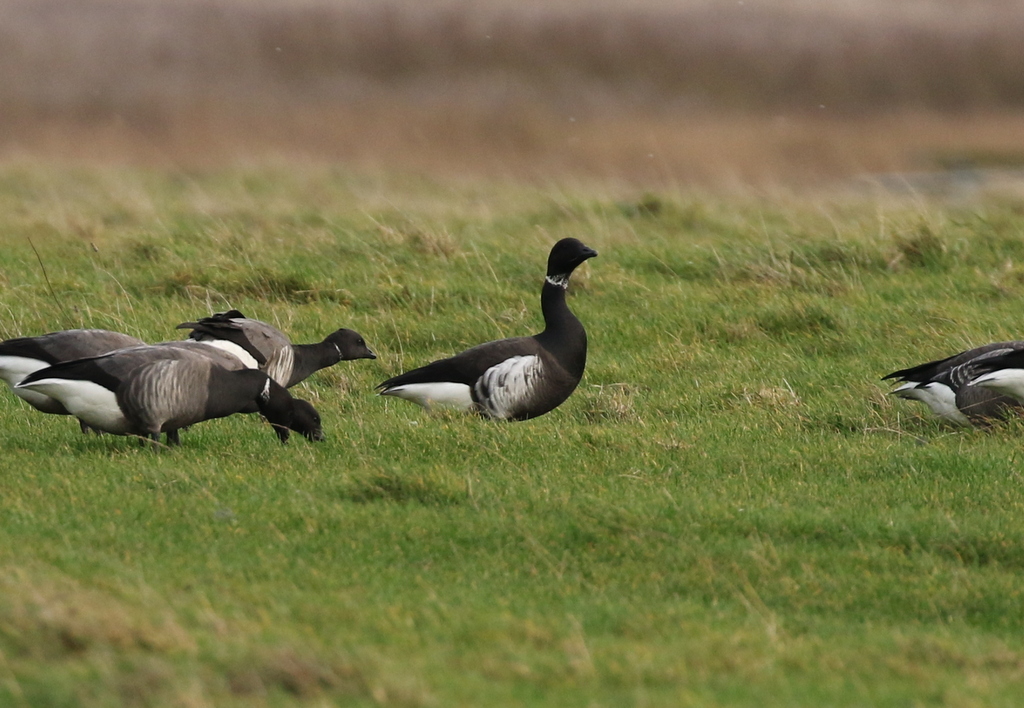 Black Brant – with the Dark-bellied Brent Geese in the Eye Field
Black Brant – with the Dark-bellied Brent Geese in the Eye Field
The wind was really quite gusty now. A Stonechat appeared close by, landing on the top a gorse bush just the other side of the West Bank from the Beach Road. A male, with a black face, it struggled to remain there in the wind.
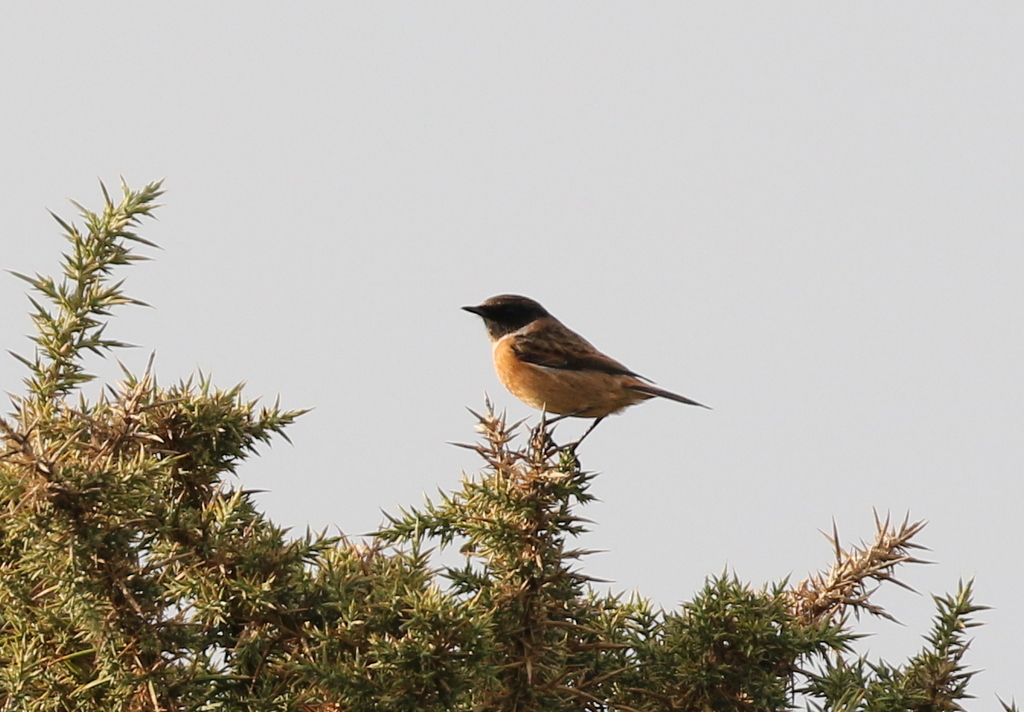 Stonechat – struggled to perch on the gorse in the wind
Stonechat – struggled to perch on the gorse in the wind
There did not appear to be much out on the reserve today, so we continued on our way west. White-fronted Goose was a particular target for the day, so we headed over to Holkham next. There are still only a very few White-fronted Geese in for the winter here yet, but we parked up overlooking the grazing marshes and started to scan.
At first, all we could see were lots of Greylag Geese down on the grazing marshes in front of us. There were a few Egyptian Geese in with them too. Thankfully it didn’t take us too long to find some White-fronted Geese, although they were a little further over today and tucked in beyond some trees.
Initially, we located a family group of four White-fronted Geese which we got in the scope. We could see the white surround to the base of the bills of the adults catching the sun. They were in the longer grass and mostly sitting down though, so it was hard to see any other details. Fortunately, we then found another pair further round and repositioning ourselves we could get a clear view. These White-fronted Geese were on shorter grass and we could see their distinctive black belly bars.
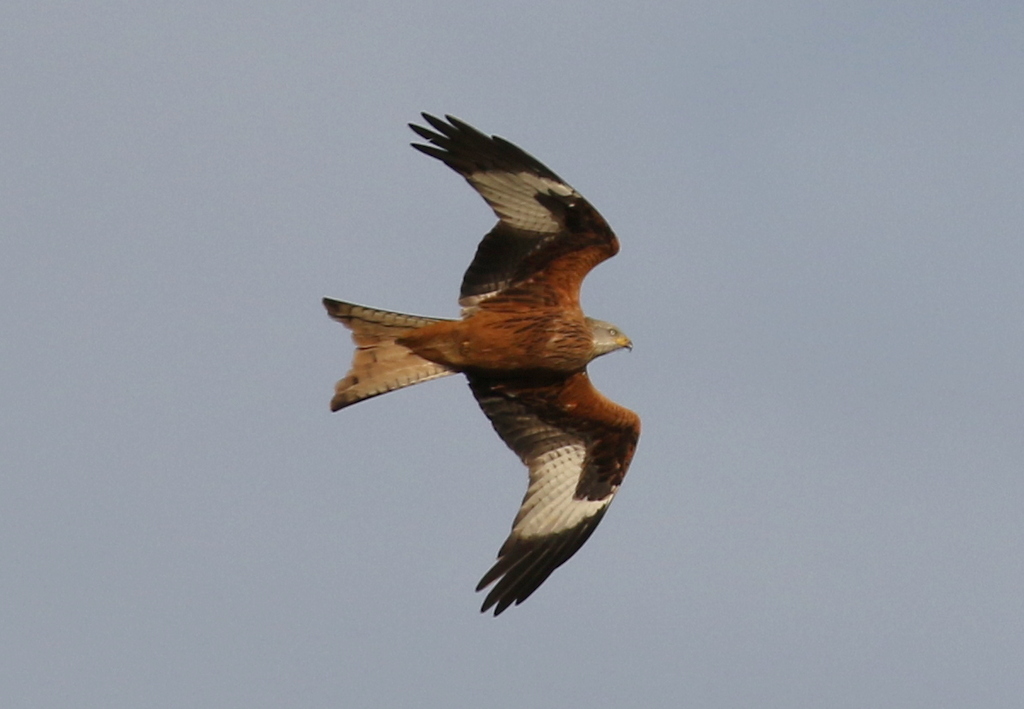 Red Kite – catching the afternoon sun
Red Kite – catching the afternoon sun
There was a nice selection of raptors out at Holkham this afternoon too. As usual, we could see several Marsh Harriers and Common Buzzards. A single Red Kite flew low over the freshmarsh, landing down on the grass for a few minutes before flying off towards the Park. It really shone rusty red in the afternoon sun. A Kestrel flew in and landed in the tree in front of us. The Sparrowhawk was slightly less obliging, flying up out of the same trees just as the gusty wind blew a blizzard of beech leaves out of the park and over the fields. It was hard to work out which was Sparrowhawk and which was leaf!
There is usually at least one Great White Egret on view here, but we couldn’t see one at first today. One of the wardens had just done the rounds and was leaving as we arrived, so we wondered whether they had flown off. Fortunately, as we were standing admiring the geese, a Great White Egret appeared up over the trees out in the middle and flew out over the freshmarsh towards us. It landed down by one of the wet ditches, where we could get it in the scope.
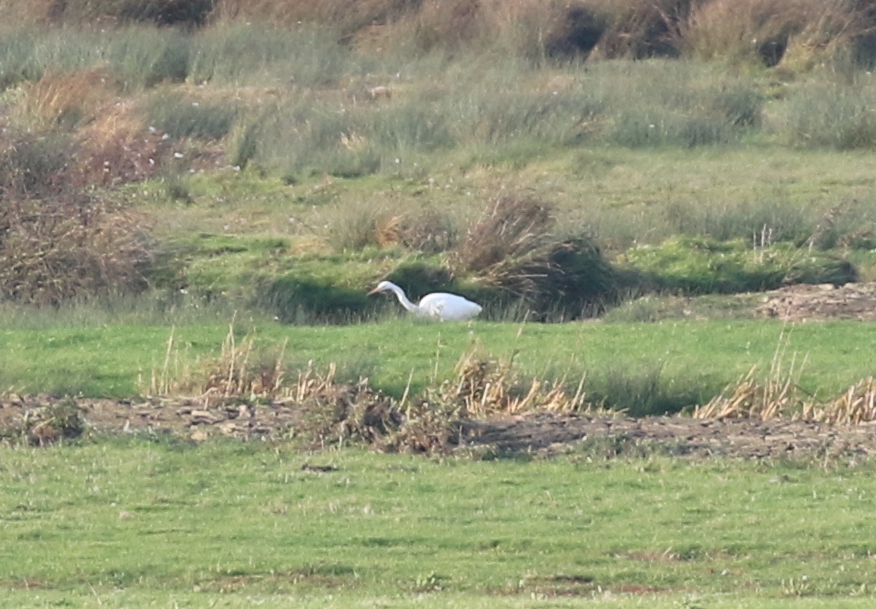 Great White Egret – flew in and landed out on the freshmarsh
Great White Egret – flew in and landed out on the freshmarsh
With the White-fronted Geese safely in the bag, we carried on west. Our next stop was at Brancaster Staithe. This is often a good place to find waders and from the warmth of the car we could see Ringed Plover and Grey Plover, Bar-tailed and Black-tailed Godwits, Curlew and Redshank. Several Oystercatchers were picking over the discarded mussels and the Turnstones were running in and out of the cars. Further out, a Greenshank was feeding up to its belly in the water in the harbour channel.
While the waders were nice, we had really come here to see the Long-tailed Duck which has been feeding in the channel here in recent days. It was low tide now, so there wasn’t much water left, but we did eventually spot the Long-tailed Duck diving a little further out in the harbour, in the deeper part of the channel just behind a muddy bank. Thankfully it then came a little closer, swimming up the channel at first, before half waddling over a submerged sand bar, and then starting to dive again.
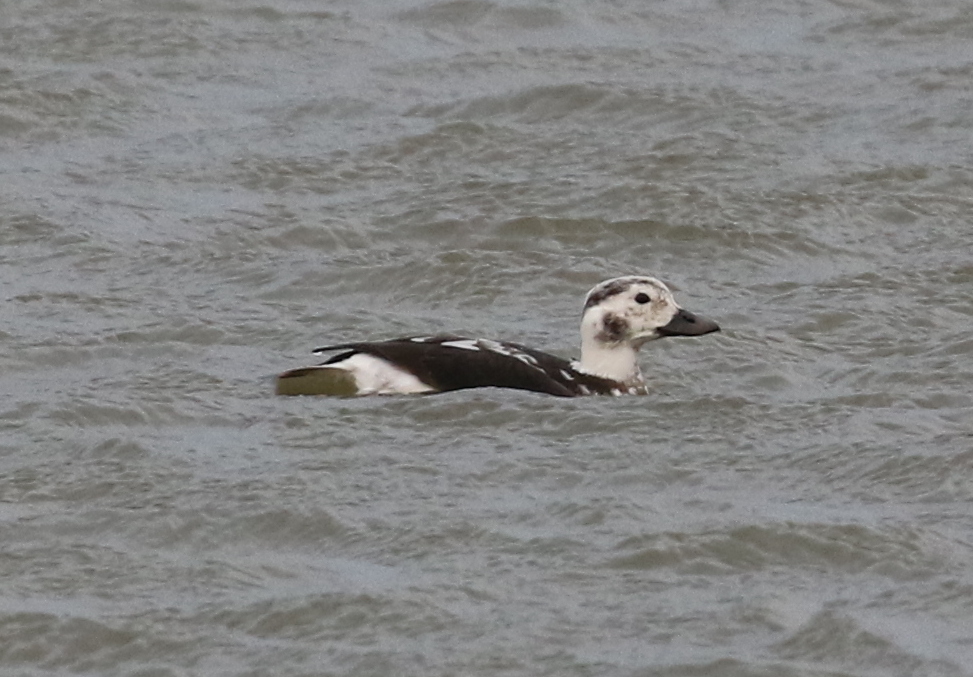 Long-tailed Duck – the 1st winter drake still in the harbour
Long-tailed Duck – the 1st winter drake still in the harbour
We had a good look at the Long-tailed Duck, though it was tricky to photograph because it was diving all the time. It could stay under for some time and then resurface some distance away. It was a first winter drake, rather pale around the head and with a scattering of white feathers in its black upperparts.
It had clouded over now and the light was already starting to fade when we finally got to Titchwell. Our main target here was Yellow-legged Gull, so we hurried out to the freshmarsh. There were already a few Marsh Harriers starting to gather over the reeds either side of the path.
We had been told that an adult Yellow-legged Gull was on the island in front of Island Hide, so we headed straight in there first. When we opened the shutters, we were greeted by the sight of hundreds and hundreds of gulls. They were mainly Black-headed Gulls but, even so, they would take a bit of searching through. There was a line of larger gulls on the island where the Yellow-legged Gull had been earlier, but as we searched through we couldn’t find it. There were just Herring Gulls, a couple of Lesser Black-backed Gulls and Great Black-backed Gulls there now.
No need to panic! We opened the shutters on the other side of the hide and started to work our way methodically through the massed throng. Thankfully, it didn’t take long to find the Yellow-legged Gull. It was quite close, on the near edge of one the islands behind a load of Black-headed Gulls. We got it in the scope and had a good look at it. It was standing in shallow water, so we could see the top halves of its bright custard yellow legs. Its mantle was a shade darker than the Black-headed Gulls around it and it had a clean white head with only limited dark streaking around the eye, very different from most of the other large gulls.
 Yellow-legged Gull – one of the adults on the freshmarsh at dusk
Yellow-legged Gull – one of the adults on the freshmarsh at dusk
When the Yellow-legged Gull sat down in the water and went to sleep, we continued to scan through the gulls. The only other gull of note we found was a second Yellow-legged Gull a bit further back – two for the price of one! There was also a nice selection of wildfowl here for the day’s list, including Greylag Goose, Gadwall, Teal, Shoveler, Shelduck and Wigeon.
With the light going now, we decided to head for home. As we walked back up the main path, we looked out across the reedbed and noticed there were loads of Marsh Harriers all in the air. We stopped for a quick count – 32 all together. It was quite a sight. Another, the 33rd, was still flying in over the reeds the other side of the path. It was a nice end to the day to see them all circling round in the wind, as we walked back towards the car.
















